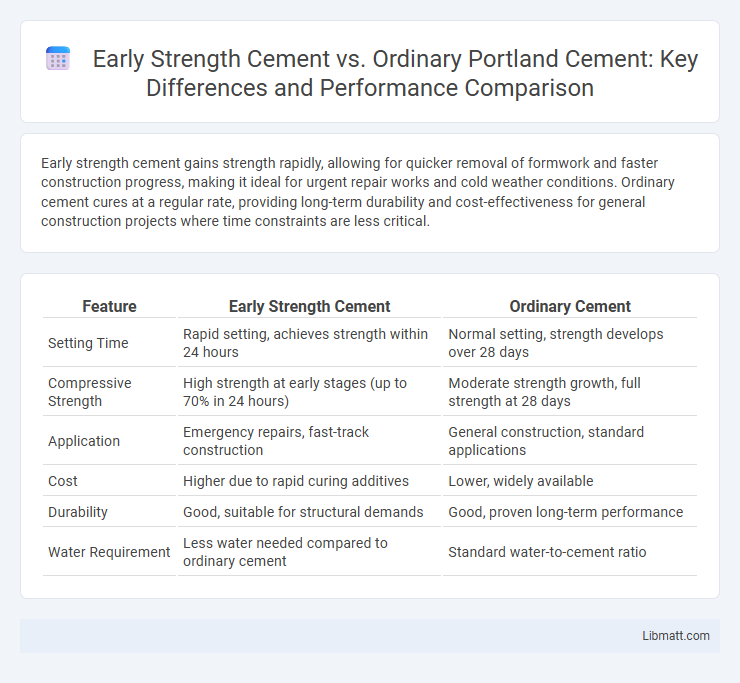Early strength cement gains strength rapidly, allowing for quicker removal of formwork and faster construction progress, making it ideal for urgent repair works and cold weather conditions. Ordinary cement cures at a regular rate, providing long-term durability and cost-effectiveness for general construction projects where time constraints are less critical.
Table of Comparison
| Feature | Early Strength Cement | Ordinary Cement |
|---|---|---|
| Setting Time | Rapid setting, achieves strength within 24 hours | Normal setting, strength develops over 28 days |
| Compressive Strength | High strength at early stages (up to 70% in 24 hours) | Moderate strength growth, full strength at 28 days |
| Application | Emergency repairs, fast-track construction | General construction, standard applications |
| Cost | Higher due to rapid curing additives | Lower, widely available |
| Durability | Good, suitable for structural demands | Good, proven long-term performance |
| Water Requirement | Less water needed compared to ordinary cement | Standard water-to-cement ratio |
Introduction to Early Strength Cement and Ordinary Cement
Early Strength Cement achieves higher strength within 24 hours due to its rapid hydration properties, making it ideal for fast-track construction projects. Ordinary Cement, also known as Portland Cement, typically gains strength over 28 days, offering reliable durability for standard construction timelines. Your choice depends on project speed requirements and structural strength needs.
Composition Differences Between Early Strength and Ordinary Cement
Early strength cement contains higher amounts of tricalcium silicate (C3S) and calcium sulfate compared to ordinary cement, which accelerates hydration and results in rapid strength gain within the first 24 hours. Ordinary cement typically has a balanced composition of C3S, dicalcium silicate (C2S), and aluminate phases that contribute to gradual strength development over 28 days. The increased C3S content and optimized gypsum levels in early strength cement enhance initial setting times and early compressive strength, making it suitable for fast-track construction projects.
Setting Time: Early Strength vs Ordinary Cement
Early Strength Cement typically sets within 2 to 4 hours, enabling faster construction progress and quicker removal of formwork compared to Ordinary Cement, which generally sets in about 30 minutes to 2 hours but reaches initial strength much slower. The rapid setting and hardening properties of Early Strength Cement make it ideal for projects demanding quick turnaround times, while Ordinary Cement is suitable for standard construction where extended curing is acceptable. Choosing the appropriate cement depends on your project timeline and strength requirements.
Compressive Strength Comparison
Early Strength Cement achieves significantly higher compressive strength within the first 24 hours, often reaching up to 10-15 MPa compared to Ordinary Cement, which typically attains only 3-5 MPa in the same time frame. This rapid strength gain makes Early Strength Cement ideal for projects requiring quick turnaround times and early load application. Your construction schedule can benefit from reduced curing periods and faster formwork removal when using Early Strength Cement.
Applications of Early Strength Cement
Early Strength Cement is widely used in projects requiring rapid construction progress such as emergency repairs, road pavements, and prefabricated structures. This type of cement achieves high strength within the first 24 hours, making it ideal for cold weather concreting and fast-track building schedules. Your choice of Early Strength Cement ensures reduced downtime and quicker readiness for subsequent construction phases compared to Ordinary Cement.
Applications of Ordinary Cement
Ordinary Cement is widely used in construction projects such as residential buildings, roads, bridges, and infrastructure where standard setting and strength development over time are sufficient. This type of cement is preferred for applications requiring durability and long-term performance rather than rapid strength gain. Its versatility and cost-effectiveness make it ideal for large-scale projects with standard curing conditions.
Cost Implications: Early Strength vs Ordinary Cement
Early Strength Cement generally incurs higher initial costs compared to Ordinary Cement due to its rapid hydration properties and specialized additives. However, Your projects benefit from reduced construction time and faster formwork removal, leading to lower labor and overhead expenses. Over the entire project duration, the cost savings from accelerated completion can offset the premium price of Early Strength Cement.
Durability and Performance Analysis
Early Strength Cement achieves higher initial compressive strength within 24 hours, enabling faster construction progress compared to Ordinary Cement, which develops strength more gradually over 28 days. The enhanced chemical composition of Early Strength Cement improves its microstructure, leading to better resistance against environmental factors such as sulfate attack and freeze-thaw cycles, thereby increasing overall durability. Performance analysis reveals that projects using Early Strength Cement benefit from reduced curing times and improved early load-bearing capacity without compromising long-term strength and durability.
Environmental Impact Considerations
Early Strength Cement reduces construction time, lowering energy consumption and carbon emissions associated with prolonged curing periods compared to Ordinary Cement. Its faster setting time helps minimize the need for additional heating or curing processes, contributing to a smaller carbon footprint in infrastructure projects. Choosing Early Strength Cement can support Your sustainable building goals by promoting efficient resource use and reducing environmental impact.
Choosing the Right Cement for Your Project
Early strength cement achieves high strength rapidly, reaching up to 70% of its ultimate strength within 24 hours, making it ideal for time-sensitive projects such as repairs or precast concrete production. Ordinary cement, also known as Portland cement, provides gradual strength gain over 28 days, offering durability and long-term performance suitable for general construction needs. Selecting between early strength and ordinary cement depends on project requirements for setting time, structural load schedules, and environmental conditions.
Early Strength Cement vs Ordinary Cement Infographic

 libmatt.com
libmatt.com